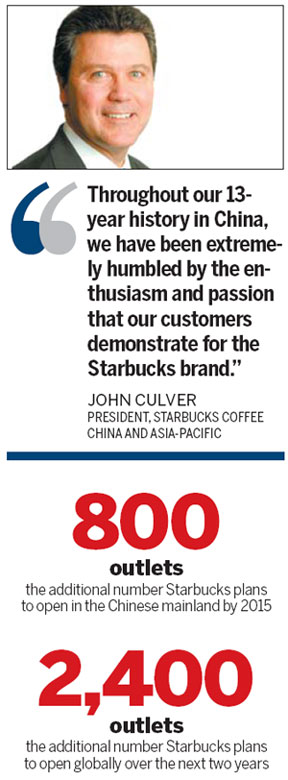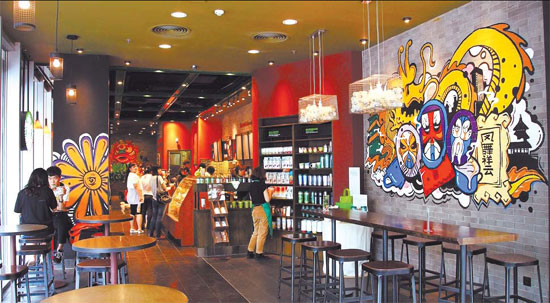Starbucks keeping its brand full of beans
Updated: 2013-02-21 07:40
By Xie Yu in Shanghai (China Daily)
|
||||||||
|
A Starbucks cafe in Beijing. The US-based coffee chain now has 700-plus outlets in more than 50 cities in the Chinese mainland. Provided to China Daily |
Global coffee chain looks for further expansion in China as it seeks to fend off rival outlets
Coffee industry veteran John Culver said he is very proud to be a pioneer in bringing the drinking culture of the beverage to this vast country with its 1.3 billion population and many thousands of years of history of drinking tea.
"Thirteen years ago, when we first entered this market, a coffee house culture did not exist in China. The Chinese had no idea what high quality Arabica coffee was and they really had no place to go to take their friends and family to try it," said Culver, president of Starbucks Coffee China and Asia-Pacific.
After opening its first outlet in the Chinese mainland in 1999, Starbucks has swept the market with its US-style coffee culture. Its image of a mermaid is now an icon of a chic Western lifestyle among Chinese people. Today, the chain consists of 700 cafes in more than 50 cities on the Chinese mainland, a firm foothold by any standard in this land of tea drinkers.
Undoubtedly many stick to their tea drinking habit. But coffee has a fast-growing appeal among younger people in big cities. To them, it's not just the coffee. It's the entire experience created by the meticulously planned and designed environment of the cafes that serve the drink.
According to the latest Euromonitor report, Starbucks has a 61 to 62 percent market share in China's coffee house sector, way above its closest competitor.
The company recently announced an ambitious plan to open 2,400 new outlets across the world over the next two years.
It has set a target of opening 800 new cafes by 2015 in the Chinese mainland alone, where it will have 1,500 outlets.
"When we look back at the last 13 years since we entered the market, we see the Chinese found ways to embrace the Starbucks experience. They have made Starbucks part of their daily ritual, appreciating high-quality espresso (for example) and also coming to appreciate a third-place environment," Culver said.
The "third-place environment", one that is neither work nor home, is new to Chinese people - traditionally, treating guests to tea in one's home is the most common and safe means of social interaction.
Nowadays more people like to meet their friends or business partners in a coffee house, which provides a cozy setting with soft couches and warm light, and also doesn't have the noise associated with Chinese teahouses.
Culver joined Starbucks in August 2002 as vice-president and general manager of food services, responsible for leading sales, marketing and operations.

His focus on building brand awareness in traditional food service venues included positioning the Starbucks brand with slogans such as "We proudly brew Seattle's best coffee".
Culver and his team worked to increase the presence of the Starbucks brand with key US customers and to ensure that Starbucks' quality standards were maintained in more than 15,000 outlets. He was later promoted to president of global consumer products and food services, leading the strategy to support Starbucks growth and expansion of product offerings worldwide, including packaged coffee, ready-to-drink coffee, ice cream and teas and drinks.
In late 2011, when Culver was about to take the position as president of Starbucks Coffee China and Asia-Pacific, he was expecting "China to become Starbucks' second home market outside the United States".
These days, as Starbucks holds the leading position in China's fast-growing coffee outlet market, his ambition looks like it will soon be realized.
The number of cafes in China doubled from 15,898 in 2007 to 31,783 in 2012. In contrast, the nation's teahouses grew by only 4 percent to 50,984 during the same period, according to a recent report from UK-based research company Mintel Group Ltd.
Coffee chains only started appearing in the mainland in the late 1990s but have since grown rapidly.
Teahouses are generally viewed as leisurely places where the elderly gather to chat and play cards, with their outdated interiors and management style deterring younger customers.
The market value of the nation's cafes and teahouses rose from 31.8 billion yuan ($5.05 billion) in 2007 to 71.6 billion yuan in 2012. Mintel predicts this will rise to 121.69 billion yuan between 2012 and 2017.
Meanwhile, more players are trying to get a slice of the big market.
Costa Coffee, from the United Kingdom, also has ambitious plans in China. It intends to have 500 cafes in the country by 2016. Hong Kong-based coffee chain Pacific Coffee also said earlier that it aimed to expand and overtake Starbucks in the mainland.
"We respect and embrace positive competition and what it brings to the market. The Starbucks experience is unique and offers something that no one else can deliver - the highest quality products, exceptional coffee knowledge, innovation and engaging baristas in a welcoming environment," Culver said, as he stressed the importance of a "direct emotional connection with customers".
"As we evolve and grow in China we are also creating that emotional connection with our customers in the digital space and rewarding them through programs such as My Starbucks Rewards. We know that we must continue to innovate and exceed customer expectations to maintain a leadership position," he said.
As for price, Starbucks is never advantaged in providing cheaper products. Culver said he does not think the company's products are "overpriced" in the China market, as some Chinese reports have said.
Starbucks evaluates pricing around the world differently, he said.
Coffee penetration or market penetration in China is very, very different, he said. In the US, for example, Starbucks' business peak is breakfast time. In China, most customers come in the afternoon and use the coffee house social destination to connect with their friends.
Since consumer behavior is very different, the way the company opens its stores, for example, choosing the location is very different, Culver said.
He made it clear there is no plan to raise prices at the moment.
"Starbucks is committed to presenting an authentic coffee experience," Culver said. However, he stressed the company is also trying to make the beverages relevant to the local community.
It has set up a research and development center in Shanghai to innovate new products that meet local customers' needs, such as introducing several kinds of teas into menus.
It has also begun to source coffee beans grown in China. Last November, Starbucks set up a joint venture in Pu'er county, Yunnan province, and opened its first Farmer Support Center in Asia to help improve the quality of local coffee beans and make Pu'er a stable sourcing region.
"The opening of the Starbucks China Farmer Support Center was a milestone in Starbucks' continued investment in China and the Starbucks Yunnan Coffee Project," Culver said, adding that Starbucks believes Yunnan will one day play an important strategic role in the long-term supply of premium Arabica coffee.
Guo Anfei in Pu'er, Yunnan province, contributed to this story.
xieyu@chinadaily.com.cn
(China Daily 02/21/2013 page15)

 In Photos: 7.0-magnitude quake hits Sichuan
In Photos: 7.0-magnitude quake hits Sichuan
 Li Na on Time cover, makes influential 100 list
Li Na on Time cover, makes influential 100 list
 FBI releases photos of 2 Boston bombings suspects
FBI releases photos of 2 Boston bombings suspects
 World's wackiest hairstyles
World's wackiest hairstyles
 Sandstorms strike Northwest China
Sandstorms strike Northwest China
 Never-seen photos of Madonna on display
Never-seen photos of Madonna on display
 H7N9 outbreak linked to waterfowl migration
H7N9 outbreak linked to waterfowl migration
 Dozens feared dead in Texas plant blast
Dozens feared dead in Texas plant blast
Most Viewed
Editor's Picks

|

|

|

|

|

|
Today's Top News
Live report: 7.0-magnitude quake hits Sichuan, heavy casualties feared
Boston suspect cornered on boat
Cross-talk artist helps to spread the word
'Green' awareness levels drop in Beijing
Palace Museum spruces up
First couple on Time's list of most influential
H7N9 flu transmission studied
Trading channels 'need to broaden'
US Weekly

|

|








